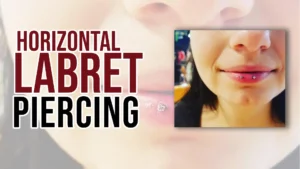Although they can be a method to express yourself and enhance your body, piercings do carry some danger. Problems from a new piercing can include migration and piercing rejection.
Take your jewelry off and consult with your piercer if you have any suspicions that something is incorrect. Frequently, a brand-new piece of jewelry is sufficient to halt migration and avoid rejection. First, evaluate why your body rejects the new piercing!
Why Your Body Rejects Piercing – Causes and Signs
Whether they like to accept it or not, millions of Americans have faced piercing rejection. It frequently occurs and usually shows up in the first few weeks following the piercings. You should be determined to adhere to the aftercare recommendations provided by your piercer.
It keeps a close eye out for any indications of rejection after obtaining a piercing. There are some things that make the piercing more likely to be rejected. Surface piercings increase your chance of rejection since the wound doesn’t go deep.
Genetics:
Not everyone recovers in the same way. There is a strong probability that you will also face piercing rejection if you have close relatives who have gone through it.
We advise you to take extra precautions to make sure it heals properly. It doesn’t become infected if you decide to push it and give it a go. Don’t say, though, that we didn’t warn you.
Weight Changes:
While this may seem strange, it is real. The skin stretches when a person rapidly puts on weight or becomes pregnant, which affects your piercing.
Infection:
While you are ill, your immunity system works extra hard to combat the infection. Unfortunately, because your body perceives the piercing as a foreign entity, it also forces the pierce out.
How You Notice if Your Body Reject Piercing?
Other warning signs of piercings rejection include the following:
Skin Changes
It can be a warning of impending rejection if the skin around your piercings looks completely different, thinner, or shorter. Also, you ought to examine the local area’s skin tone. When the skin surrounding it appears transparent, you should consider the possibility of rejection.
Migrating Jewelry
There’s a good probability you’ll be rejected if your jewelry starts migrating. Even though there have been instances where jewelry that was migrated was not ultimately rejected. You would not even be satisfied with the way it looked. Professional piercers advise you to spot migration as soon as you can as a result.
Extended Inflammation
The procedure includes inflammation, as was already explained. Every new piercing has early inflammation, but it should go away in a few days. If the infection increases, the skin from around the piercing begins to peel or start flaking, or calluses start to form. You’ll realize the piercing is likely to be rejected.
How Can We Prevent Piercing Rejection?
Discover who the top piercers in your area are by conducting some research before having a new piercing. Remember that piercings could result in visible scars.
Here are some ways to reduce your chances of being turned down:
- Purchasing a wider gauge could lower your chances of being turned down.
- Discuss the depth of the piercings and the ideal size of jewelry to wear while you’re healing with your piercer.
- Observe all aftercare requirements. Keep the area clean and apply a saltwater compress on it.
- Be healthy, eat right, and attempt not to stress yourself.
Ask the piercer about their experience unless you’re getting a surface piercing. Therefore, asking about the probability of rejection for the place you want to pierce is a smart idea.
Conclusion:
Your body might reject a fresh piercing. However, research suggests that it can. So much worse, it can force it out of you. Hence, even though your mind is delighted with your new jewelry, something else requires permission, and that something else is your body.
A piercing is an open wound, and your body will treat any wound (either from an accident or, in this case, a purposeful act of body art) right away. Therefore, some people have no issues with wound healing.
Some, however, are forced to suffer a painful process that is mentally and physically taxing because their systems refuse to accept the piercing. This situation is referred to as piercing rejection. However, what causes piercings to be rejected, and how can you avoid it?
FAQs:
How can you prevent a piercing from turning down a scar?
Follow your piercer’s advice while cleaning fresh piercings if you’re prone to scarring.
- When a piercing heals, avoid wearing jewelry.
- Use just the products that your piercer has advised.
- For new scars, apply silicone gel or sheets.
If my piercing rejects, can I still keep it?
There’s a good probability they’ll advise removal if your piercing is already spreading. Removing it now poses little risk, but keeping it in could harm your skin and make it challenging to pierce the area after healing.
Can piercings reject under stress?
Your piercing may be rejected for a variety of reasons. Stress, heredity, weight gains, and the thickness of your skin are all examples of personal factors that can contribute. External factors like improperly sized jewelry and subpar jewelry quality can also cause a piercing to fail!
Click on the given link to know different ways to heal your piercing faster.





